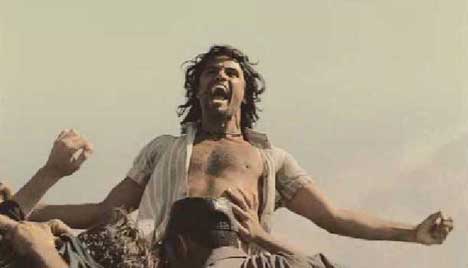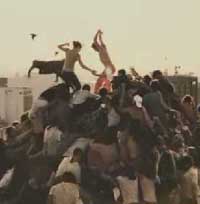
A screenshot from a Sony commercial, “Mountain,” which is a fair allegory for working in freelancing. He’s at the top of that mountain, for now. Fierce, isn’t it?
July 12, 2012
I was walking to my interview with Michele Clement in San Francisco’s sunny Mission district, and I couldn’t get Shirley Temple’s “De Gospel Train” out of my head. It’s an odd song to have in your head in 2012 but it has a special meaning to me.
In November 2003, Sony Corporation released an advertisement called “Mountain.” In it, people all over a metropolitan area drop what they’re doing and rush towards the city center. There are so many of them that, as they pile atop each other, they begin to form a mountain that envelopes buildings and dwarfs skyscrapers. In the final shot, the camera zooms in on the top of the mountain as one person after another triumphantly reaches its zenith and then is shunted aside by the next victor, all set to Shirley Temple’s tune.
Soon, I’ve reached Michele’s studio. After she offers me an apple, we start talking. I’ve known her for some time, so it’s an easy interview. To make a living, she’s a freelance commercial photographer and does fine art photography when she can. She’s been freelancing for 30 years. We spoke about how the industry has changed, how getting work is much more difficult now and how the market is becoming saturated with young, inexperienced so-called “creatives”.
Before 9/11, assignments would appear faster than she could complete them. There was an assumed rate for professional photography of a certain skill and experience level. The profession required education, whether acquired through school or an apprenticeship. Things like the correct white balance, lighting, ISO and F-stops all required a learned relationship between tools and their master.
Today, work is scarce. After 9/11 panic caused advertisers to pull a lot of their work, fearing the unknown climate of what people might find alluring or offensive. Now, buyers dictate pricing for work and often ask photographers to accomplish the impossible. Two-day shoots must be done in a day.
“It’s like being asked to stuff a dog into a film canister,” Michele said.
But mainly, there are just more people who want to be — and think they already are — professional photographers. There is a stigma against non-creative work among my generation. Many of us feel that if we aren’t in a loft apartment working on a MacBook for a living, we screwed up somehow.

This screenshot from a Sony commercial is about as true to life as it gets to living as a freelancer.
Being a photographer is appealing and digital cameras have made that more possible than ever, especially since Michele entered the trade. White balance? ISO? Focus? Much of this is automatic, pre-set into the camera. Photoshop was once an arcane art, known only by industry professionals using expensive machines.
Today we have Instagram, and everyone is a photographer.
“Taking pretty pictures is actually a very small part of what it means to be a professional photographer,” she said.
She’s right. I could replace a few nouns in this article and be talking about journalism. In either profession, it seems that managing contacts and finances make up the bulk of a successful professional’s workload.
We’re in an age of mountains. There are more than 110 million additional people in the U.S. than in 1970. The increasingly competitive market requires photographers to produce ever more work in an ever-narrower time frame and promote themselves aggressively through social media and networking.
I asked Michele if there was anything hopeful I could use to close this article with. She said no.


 The Hunger Site
The Hunger Site
July 12, 2012 at 6:17 pm
Great article Augustine!